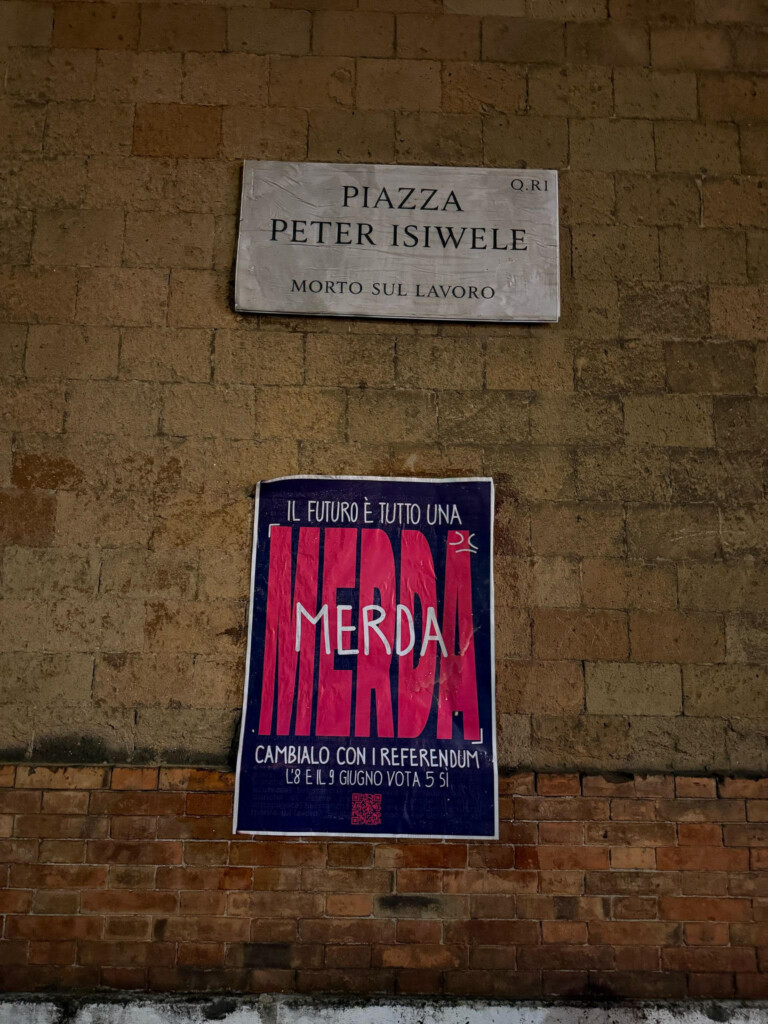Reportage
Roman streets are taking the names of people killed at work
Since 2005, more than 25,000 people in Italy have died in the workplace. Student activists are renaming the streets of the capital in their honor.

They have changed the street names in Rome, renaming some of the streets in the city center with the names of those who died in the workplace. This is an initiative of the activists from the “Studenti per i 5 sì” (“Students for 5 Yes votes”) committee – referring to the five referendums which will take place simultaneously on June 8 and 9 – changing the face of the Italian capital on the eve of May 1.
Viale Trastevere, home of the Ministry of Education, has become Viale Lorenzo Parelli, the young high school student who was killed while on a student internship (formerly the “school-to-work pathway”).
Piazza Vittorio Emanuele has become Piazza Satnam Singh, the farm laborer who died in Latina after losing an arm in a work accident and being abandoned at home by the farm owner, now on trial for voluntary manslaughter due to intentional negligence.
Via di Santa Croce in Gerusalemme has been dedicated to Peter Isiwele, the worker who died when an elevator platform collapsed, while Piazza dell'Immacolata has been renamed Piazza Luana D'Orazio, a 22-year-old girl killed in 2021 when she fell into the gears of a warping machine at the factory where she worked near Prato.
Piazza della Repubblica has become Piazza Massimo Mirabelli, who died on the job on the first day of his probationary period at age 76 due to ill health: he had been forced to go back to work because the pension he received after working in the transportation sector was not enough to make ends meet.
“We chose this symbolic initiative on the eve of May 1 because, in a democratic state that recognizes May Day, it is unthinkable that people still die on the job, are exploited, or live their entire lives as precarious workers,” explains Bianca Piergentili, spokesperson for the committee that was born out of the Student Network.
Since 2005, more than 25,000 people in Italy have died in the workplace. Since the beginning of the year, the Bologna Occupational Deaths Observatory has recorded 315 deaths, a figure that rises to over 400 if you count those on the road. INAIL data for the first two months of 2025 includes 138 fatal accident reports, a 16 percent increase over the same period in 2024. “The referendum on citizenship is of enormous value for the world of labor as well: it would mean freeing workers from the obligation to accept precarious contracts in order to chase a residence permit, as well as a first step toward stamping out undeclared work and exploitation. A ‘yes’ vote is crucial,” Piergentili continued.
The students feel that they are protagonists in the referendum battle, aiming to reform the laws governing the world of work, starting with the repeal of the measures making it easier to fire workers introduced by the Jobs Act in 2015.
“The impossibility of being reinstated after an unlawful dismissal is first and foremost a penalty against the new generations, who are entering an unstable labor market in perpetual crisis. This norm makes us blackmailable, with no guarantees. We are simply demanding that workers' rights be put at the center instead of the logic of the market,” the activist says. He adds: “Patchwork measures on workplace safety are not enough. We need a systemic reform that guarantees the right to refuse to work in dangerous conditions, that punishes the lack of safety equipment in factories, and that provides for the constant inspection of workplaces.”
This protest action is also aimed at publicizing the campaign for the early June referendums promoted by the CGIL union – involving five questions, four on labor rights and one on citizenship rules. The students fear the possibility of a low turnout that would leave the results invalid.
Originally published at https://ilmanifesto.it/gli-studenti-romani-cambiano-i-nomi-delle-strade-per-i-morti-sul-lavoro on 2025-05-01
